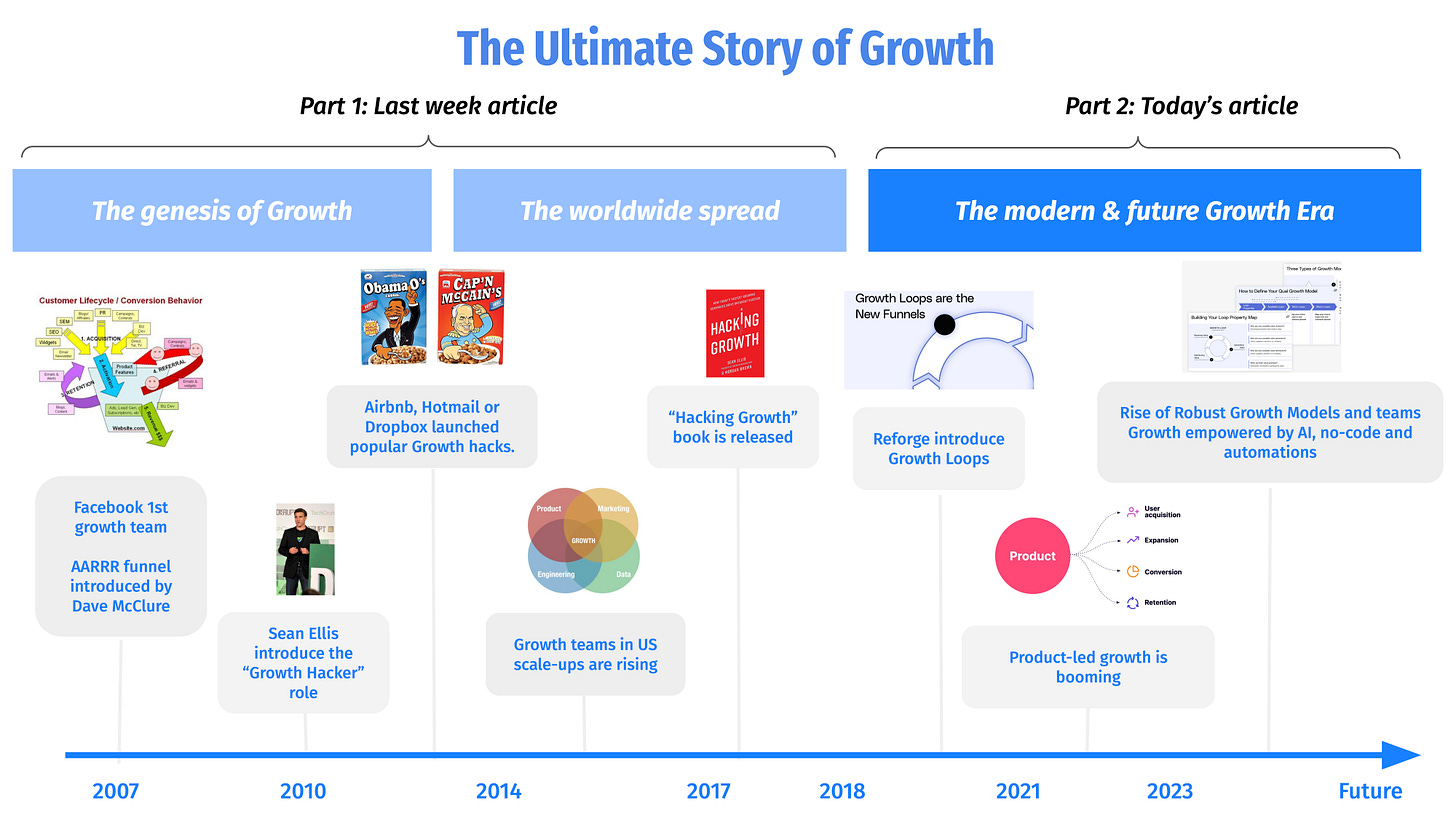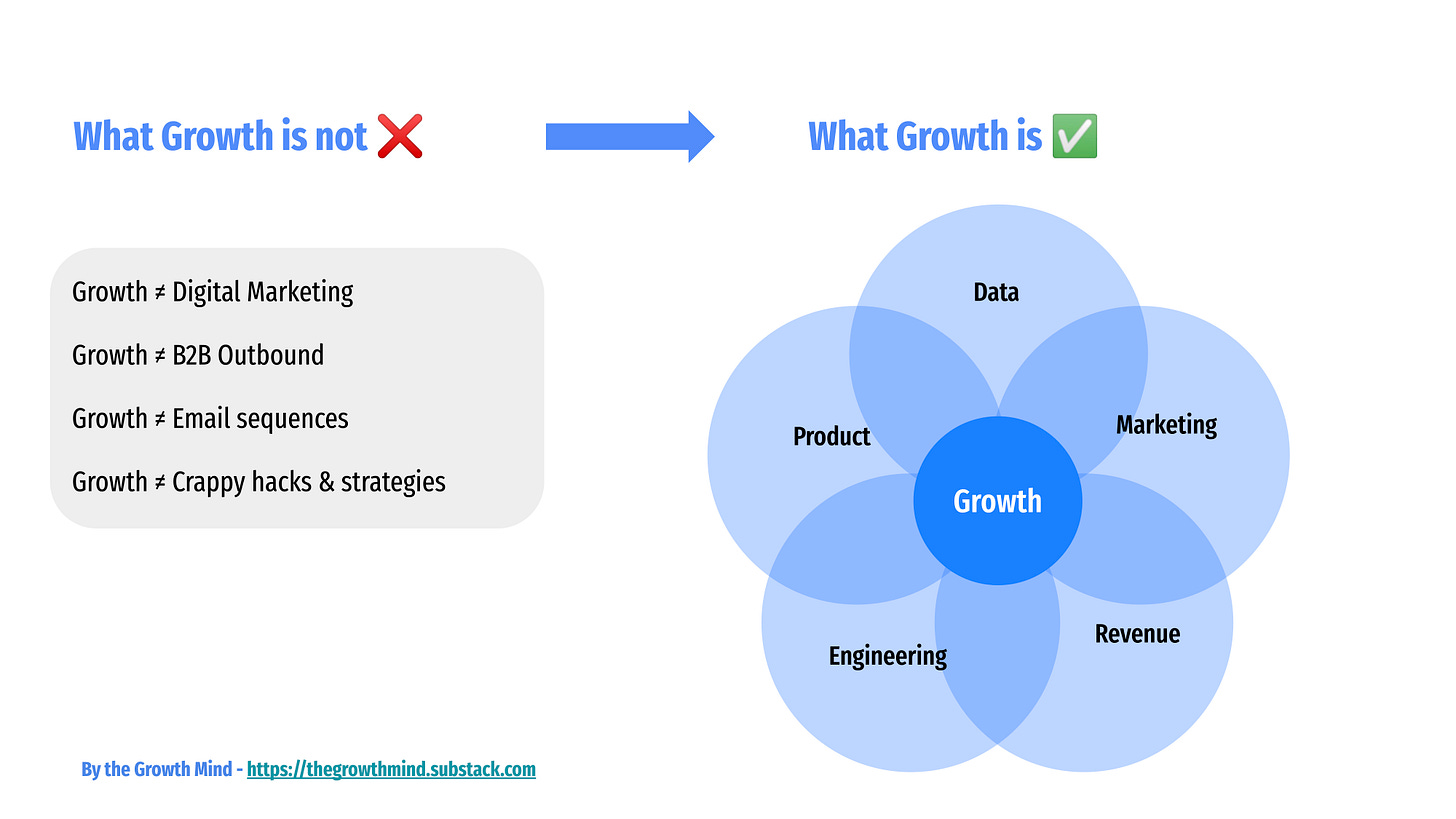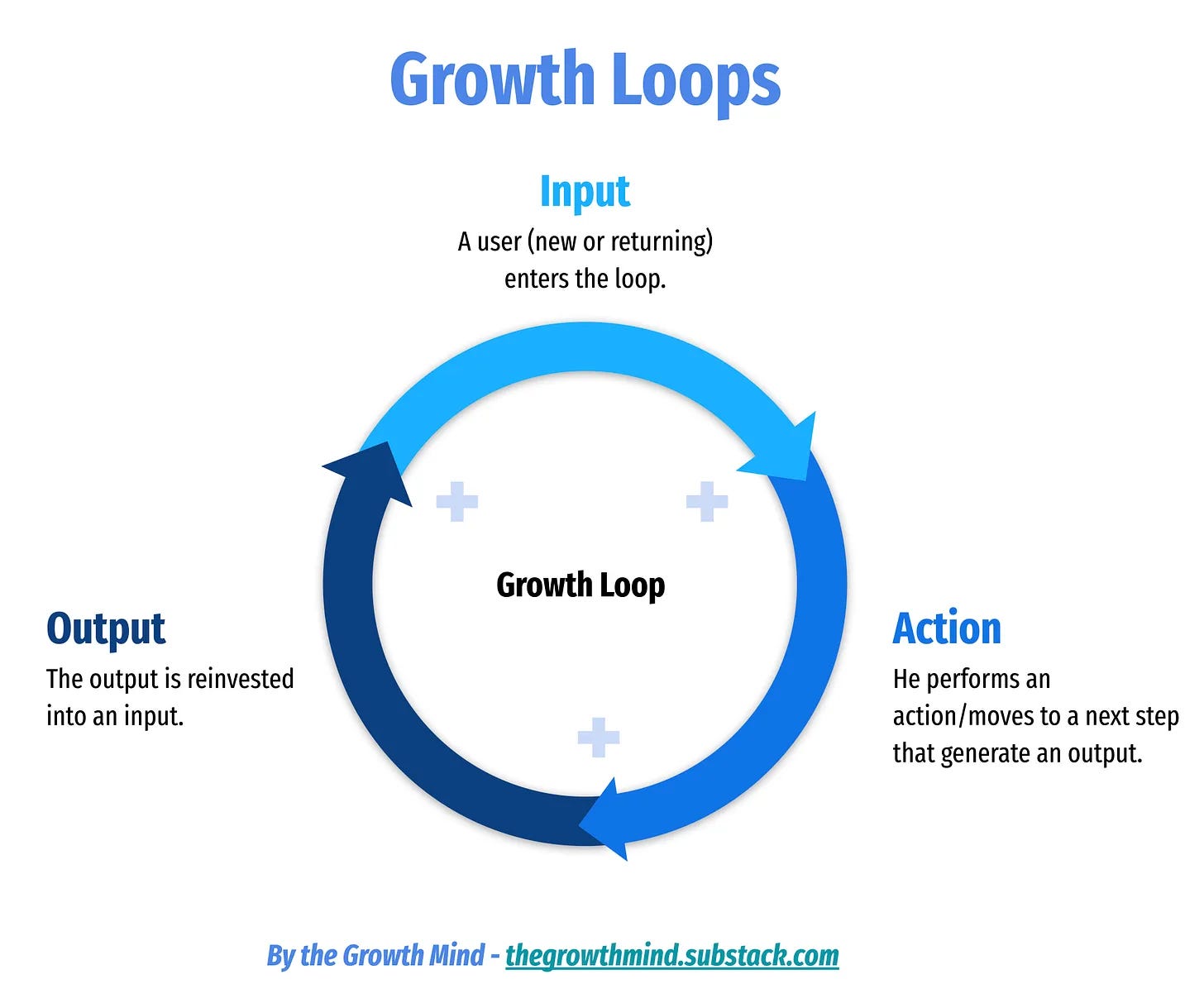The Ultimate Story of Growth - Part 2
The Modern & Future Growth Era: Navigating Loops, Growth Teams, Product-Led, AI and No-Code
Hi there 👋 Welcome to this new edition of The Growth Mind!
I talk every 2 weeks about Growth and Tech topics, inspired by the world’s leading scale-ups.
Today’s article -The Modern & Future Growth Era- is the second edition of a two-post series about the Story of Growth.
If you missed the 1st part, you can read it here: The Genesis and Evolution of Growth Hacking
The Modern & Future Growth Era: Navigating Loops, Growth Teams, Product-Led, AI and No-Code
In the first part of the Ultimate Growth Story, we discussed the genesis of Growth Hacking and its spread over the world in less than 10 years.
We are now entering a new era, where growth is becoming a mature discipline, fully integrated into the best scale-up organizations, and evangelized by famous voices from the tech world.
So today, we’ll focus on what is the modern growth approach and how it will evolve in the future.
📈 Growth is now approaching a maturity stage
Growth, as we defined it in the 1st part of the Ultimate Growth Story (The Genesis and Evolution of Growth Hacking) is:
A data-driven mindset, focusing on rapid experimentation.
Adopted by high-growth tech companies.
Promoting a cross-functional approach (teams composed of individuals from Product, Marketing, Data, and Engineering).
Focusing on each stage of the user journey, from acquisition to monetization, passing through engagement and retention.
Actually, modern growth is still relying on those strong foundations that have been created by the first growth teams and democratized by Sean Ellis.
But while Growth, in its infancy, was mainly a secretive method adopted by a few tech enthusiasts from Silicon Valley, the approach has become more documented over the years.
Growth is becoming more and more documented and conceptualized.
Famous growth influencers, like Andrew Chen, Lenny Rachitsky, or Elena Verna, appeared:
They have hundreds of thousands of followers.
They worked in Growth roles for some of the most well-known tech companies (Airbnb for Lenny, Uber for Andrew, Dropbox & Miro for Elena).
They strongly documented how those companies were doing growth, by building and sharing frameworks, strategies, stories, and so on.
They are the new voices of a professional Growth discipline, fully embraced by the biggest tech companies, far from the crappy hacks focusing on acquisition we’ve seen popping while growth hacking was spreading over the world.
Reforge, often called the “School of the Silicon Valley”, has played an essential role in this level up of Growth by:
Conceptualizing how the biggest scale-ups approach Growth.
Introducing new frameworks and methodologies (see below with growth loops) which are now famous in the industry.
Encouraging top growth leaders to share their knowledge through cohort-based courses, articles, and interviews.
Their impact on Growth, and more broadly the tech world, is incredibly significant.
More generally, a bunch of smart people working on Growth participated in this professionalization of Growth by sharing content, documenting their org, and the impact of their actions.
🧠 Cross-functional growth teams are becoming the new standard in high-growth startups
In the beginning, growth was a discipline mainly owned by a single individual in a company: the Growth Hacker. He was the only person entirely focusing on Growth, trying to do magic with his two hands.
Spoiler: one person, no matter how good he is, can’t scale the Growth of a company wanting to become a unicorn.
It makes total sense to have only one role dedicated to Growth in the early stage, with someone being more of a growth generalist capable of working on all funnel stages and activating all channels/levers. Someone who’s good at doing the 0 to 1.
But scale-ups are now relying on entire teams composed of dozens to hundreds of people focusing on Growth. Teams are composed of multiple profiles, ranging from generalists to specialists.
“The majority of growth teams have up to 20 members dedicated partially or fully to growth” - “State of Growth Report” from growthhackers.com
From generalists to specialists, we generally find the growth profiles composing growth teams:
Head of Growth: Manage the team, build the roadmap, and make sure the team is focusing on the most impactful growth projects.
Growth Marketer: Drive growth over the whole funnel by leveraging marketing channels and tactics.
Growth Product Manager: Enhance product features to improve user acquisition, activation, and retention.
Growth Engineer: Build and automate growth-related features and tools.
In addition to those profiles that are focusing 100% of their time on Growth, we generally find in Growth teams other complementary profiles like Data analysts and Designers. They play a crucial role in helping the growth deliver and analyze their actions.
Depending on the team size and maturity, you might find multiple individuals with similar profiles, as well as hyper-specialized roles (e.g., growth outbound or growth inbound manager)
Growth teams can be integrated into organizations in 3 ways:
1# As an independent team
Managed by a Head of Growth.
Growth team members dedicate 100% of their time to Growth.
2# As a cross-functional taskforce
People from different departments, under different managers, collaborate on Growth.
They don’t necessarily dedicate 100% of their time dedicated to Growth.
3# As a mixed structure
A team with a head of Growth and growth-focused people, helped by people from other teams dedicating a part of their bandwidth to Growth.
🔄 Loops are replacing funnels
Introduced in 2007 by Dave McClure, the funnel AARRR was for years the reference framework used by Growth people. It’s a framework, as we saw in part 1 of the Ultimate Growth Story, which had a considerable impact on how companies visualized their growth models.
However, the AARRR framework has been gradually supplanted by a new framework introduced by Reforge in 2018: Growth Loops.
The main critics of the AARRR funnel are:
It creates silos between teams (marketing owns acquisition, product owns activation and retention, sales owns revenue), making it difficult to create growth strategies addressing the whole customer lifetime.
It has a linear vision: The funnel must be continuously fed to drive growth, making growth strategies focus too much on acquisition.
Growth Loops allow companies to visualize growth in the form of a loop in which each Input, through an action or by passing a step, produces an Output.
This virtuous cycle helps achieve compounding growth effects, by visualizing different stages of the customer journey within the same loop and breaking silos between teams.
Growth Loops are now considered a new reference framework for growth leaders, especially in the US, shaping a new way we build growth models in companies.
It’s a framework that particularly suits the way cross-functional growth teams we talked about before work.
Despite being created 5 years ago (in 2018), Growth Loops are still a framework relatively unknown outside of the US tech world. It became a reference for top-notch startups, but it’s a small niche yet.
For example, in Europe, very few companies visualize their growth with loops. The concept is still nebulous, and funnel vision is still predominant from what I see.
But the story was the same for the AARRR funnel, which was created in 2007, but started being mainstream in the startup world around 10 years later.
My bet is that Growth loops will continue rising in the coming years, to become a mainstream concept considered as a reference to model growth.
🧑💻 The rise of Product-Led Growth in the B2B SaaS industry is shaping new growth standards
Growth has been changing for a few years, and the surge in Product-Led Growth (PLG) is significantly contributing to this change.
Since Covid, the hype around PLG has been crazy. See below how the trend spiked up at the end of 2021:
In a nutshell, Product-Led Growth is a model that positions the product as the main driver of growth, retention, and revenue.
PLG products generally exhibit key traits like:
Self-serve products, easy to try
Freemium or Free trial business model
Strong focus on engagement and retention
Products built to become viral
While putting the product as the main growth driver is not new in some industries, like B2C mobile apps, it’s a new approach for the SaaS industry, which is one of the most important industries in the tech world.
The rise of PLG is drastically changing the way many companies approach growth, and then also the job of Growth people:
Lead generation through outbound channels (cold email, Linkedin…), was a cornerstone of growth for some companies but is becoming less efficient. Automated outbound is declining.
Most successful SaaS have understood that a great product, driving engagement and retention, is what unlocks acquisition and monetization. They start with a PLG motion, growing their user base with individuals. Selling to teams is either done through the product or through the help of Sales.
The focus is more and more on designing self-serve flows that convert, and build low-friction pricing models making it easy to test and experience the value of a product,
Those areas of focus mean Growth people should experiment in-product, not only outside product, to drive top-funnel volumes.
→ The massive shift from Sales-Led to Product-Led growth is already happening, and will without any doubt continue in the coming years.
But there is still a long way to go. PLG is relatively well known in the US tech ecosystem right now, but in Europe, the concept is still pretty early.
However, I truly believe this will quickly change, as many promising startups adopting the PLG method are popping up every month thanks to the work done by Growth influencers at evangelizing it.
One other thing making me think PLG will continue rising is that it fits particularly well with Growth Loops. So my bet is the two concepts will rise together, each other benefiting from their respective help.
PLG is strongly shaping the modern & future growth era, making it a methodology everyone working on Growth should learn and master at some point.
The rise of new methodologies like PLG, which are conceptualized, taught and explained by tech influencers, clearly indicates that Growth is at a mature stage and is now a fully professional discipline.
🤖 The Future of Growth will rely on robust Growth models, where AI and No-Code empower individuals
Growth is now a discipline:
Fully integrated into the biggest scale-up orgs.
Taught and documented by top influencers.
Which has its very own set of frameworks, methodologies, and tactics.
Top companies are building strategies relying on robust Growth models, tailored to their unique attributes. Growth is no longer a discipline mastered by a few growth hackers.
Growth models map how products grow, focusing on each stage of the user experience (acquisition, activation, retention, revenue). Those growth models are composed of different growth loops, each of them having its purpose (driving acquisition, boosting engagement or activation, and so on). While a few top-class scale-ups have yet to adopt these robust growth models, their examples are shaping a path to democratizing those models over the next few years.
Another phenomenon drastically shaping the future of Growth is the rise of No-Code and AI.
It has never been easier to launch a product, design an experiment needing custom code, or design a new screen since no code and AI arrived.
This change means every growth people now have more power in their hands. Technical barriers, and even creative ones, are partially being broken by no-code and AI.
What does it change concretely?
A person working lonely on growth in an early-stage company would be able to ship more experiments, and probably more technical ones. Someone who has a product/marketing profile can already use chat GPT or a no-code builder to build experiments needing some code, which before would have needed the help of an engineer.
A team with cross-functional profiles will be empowered by no-code and AI tools to build and launch new projects. I strongly believe engineers will not be replaced by AI, as their technical and scientific knowledge is more valuable than ever. On the contrary, new tools will make them even more powerful.

We are still in the early life of AI, but we are already seeing smart use of it when doing Growth.
AI can already help to do things like fill your experiments backlog with fresh ideas, create content for your marketing campaigns, or calculate A/B test results.
Looking at the recent progression curve of AI tools, it looks like the next few years will be insane.
From fully AI-generated ad creatives to automated creation of paywall variants to A/B tests, the potential of AI coupled to no-code is amazing.
With fewer technical and creative barriers, the comprehension of users and their motivations (AKA jobs to be done) will likely become more important than ever.
In the Future Growth Era, the core principles of Growth will remain unchanged: the data-driven mindset, emphasis on experimentation, and cross-functional approach have proven their effectiveness.
The definition of Growth Hacking invented by Sean Ellis will still continue to be a reference for the growth people.
But robust growth models and modenr growth teams, paired with new trends like PLG, AI, and No-code are shaping a new future.
The landscape of growth will continue to quickly evolve. Continuous learning, perpetual curiosity, and adaptability are essential to stay abreast of the changes.










Love love love this edition! Really well explained.
About the AARRR funnel, I believe it's more of a framework to guide the search of growth opportunities - not a sales funnel.
I love this article, Thanks Pierre! Thanks so much, sharing it immediately on my LinkedIn. The timeline is so dope & guess what I will ask you when we are recording GTM Strategist Podcast today 😃